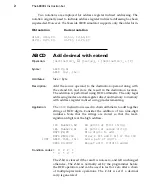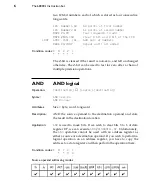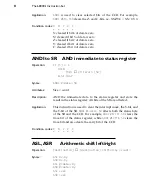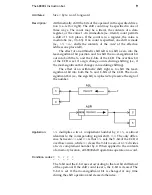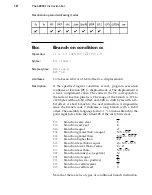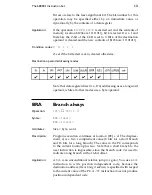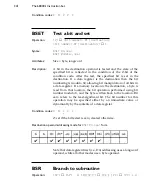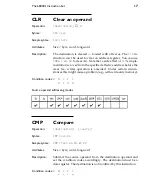
2
The 68000's Instruction Set
Two notations are employed for address register indirect addressing. The
notation originally used to indicate address register indirect addressing has been
superseded. However, the Teesside 68000 simulator supports only the older form.
Old notation
Current notation
d(An), d(An,Xi)
(d,An), (d,An,Xi)
d(PC), d(PC,Xi)
(d,PC), (d,PC,Xi)
ABCD
Add decimal with extend
Operation:
[destination]
10
←
[source]
10
+ [destination]
10
+ [X]
Syntax:
ABCD Dy,Dx
ABCD -(Ay),-(Ax)
Attributes:
Size = byte
Description:
Add the source operand to the destination operand along with
the extend bit, and store the result in the destination location.
The addition is performed using BCD arithmetic. The only legal
addressing modes are data register direct and memory to memory
with address register indirect using pre-decrementing.
Application:
The
ABCD
instruction is used in chain arithmetic to add together
strings of BCD digits. Consider the addition of two nine-digit
numbers. Note that the strings are stored so that the least-
significant digit is at the high address.
LEA Number1,A0
A0 points at first string
LEA Number2,A1
A1 points at second string
MOVE #8,D0
Nine digits to add
MOVE #$04,CCR
Clear X-bit and Z-bit of the CCR
LOOP
ABCD -(A0),-(A1)
Add a pair of digits
DBRA D0,LOOP
Repeat until 9 digits added
Condition codes:
X N Z V C
* U * U *
The Z-bit is cleared if the result is non-zero, and left unchanged
otherwise. The Z-bit is normally set by the programmer before
the BCD operation, and can be used to test for zero after a chain
of multiple-precision operations. The C-bit is set if a decimal
carry is generated.
Содержание 68000
Страница 1: ...Motorola 68000 s Instruction Set ...
Страница 2: ......




